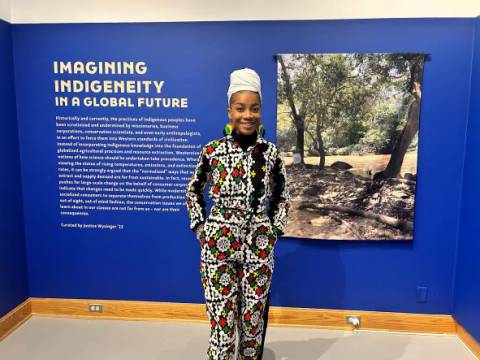Major/Minor: Anthropology
Hometown and State: Chicago, Ill.
What are your favorite memories or activities as a Colgate student?
My favorite memories at Colgate include the OUS summer experience before starting my first year and collaborating with LASO to organize the Celebration Familiar event last semester. I love participating in mountain biking led by Outdoor Education whenever I can, and I am also working with a group of talented individuals to form a step group on campus. All these moments and activities here at Colgate always allow me to bond with my peers and also have fun while doing so. Additionally, I enjoyed a semester abroad in Copenhagen, Denmark, in the fall semester of my junior year; this opportunity allowed me not only to see but also immerse myself in a different culture, both academically and socially.
You recently completed your senior thesis and curated an exhibition as part of your scholarship. Please tell us more about this academic experience.
Writing my senior thesis was a grounding process for me: it involved me delving into aspects of my own traditional Yoruba spirituality, Isese Lagba or Ifa, in ways that had been unfamiliar to me. In doing this research, not only was I encouraged to draw on my personal experiences as a priestess, but I was also utilizing methods that grounded these experiences in various literature about Ifa, anthropological literature that addresses the ways that religion is socially produced and reproduced, and material culture through my work with the Longyear Museum of Anthropology. My research focuses on the pollution of the Osun River, located in Osun State, Nigeria, via illegal gold mining, as an attack on cultural ecology. I analyzed this case of environmental degradation and Yoruba divination items in the Longyear collection with an intersectional lens, using frameworks and concepts from cultural anthropology, environmental injustice, and material culture. Ultimately, I learned more about my own spirituality and validated ways of belief and expression that are not normalized in Western societies.
I am grateful for the opportunity to expand my thesis to encompass an exhibit that highlights knowledge from Indigenous peoples around the world at the Longyear Museum of Anthropology. It highlights Indigenous material culture and cultural ecology from the Haudenosaunee, Yoruba, and Guna peoples; simultaneously, it addresses cases of environmental injustice occurring in these respective places and explains how it directly impacts shared traditions and beliefs. Overall, I aimed to link human-environment interactions on local and global scales while also explaining the processes and patterns of erasure towards Indigenous ways of knowing. It was amazing to have my mother, Iya Ifatola Tifase, on campus for the opening of the exhibit and to share her knowledge and experience with the Colgate community: my mother is the reason I am here today and doing what I am now. My bosses, Rebecca Mendelsohn and Summer Frazier, have been crucial in manifesting my ideas into a powerful exhibit. I am also grateful to the Longyear team for their hard work in opening this exhibit and to all of my professors at Colgate, who have shared their knowledge and stories with me. Being able to do this type of work and research will forever have a tremendous impact on my Colgate experience: it showed me what it is like to have a learning community support my vision.
What advice would you have for others interested in OUS and Colgate?
I would tell them not to be afraid to push themselves out of their comfort zone to meet new people and embrace new ideas. Colgate has fostered an excellent environment for me to do so, and I will always be grateful for the support and empowerment that both the resources and people at Colgate have to provide. OUS has enriched my time at Colgate; it has helped me make friends for a lifetime and provided me with the support that enabled me to thrive as a BIPOC student from the inner city. I am excited for more students to share such an experience.
